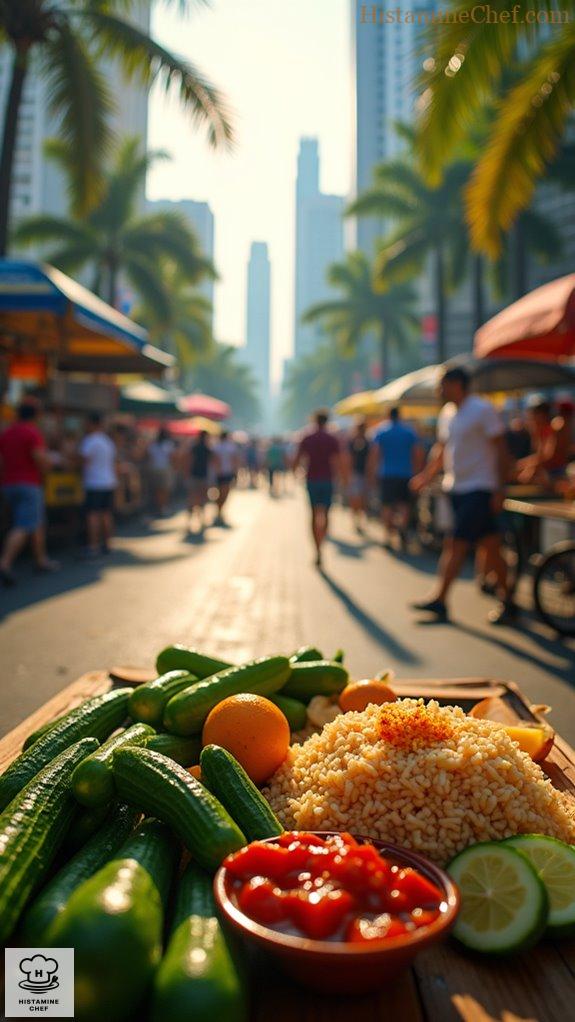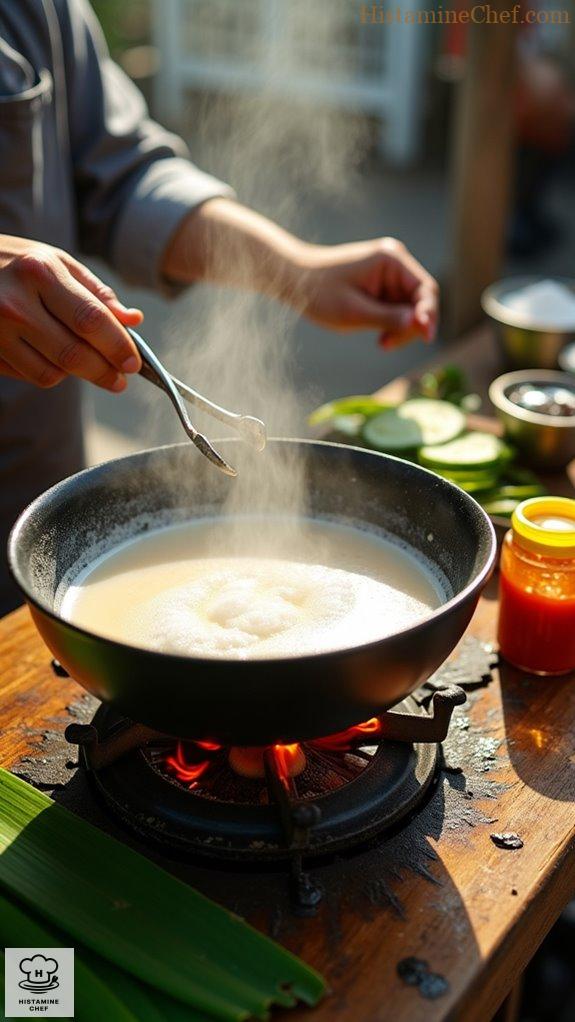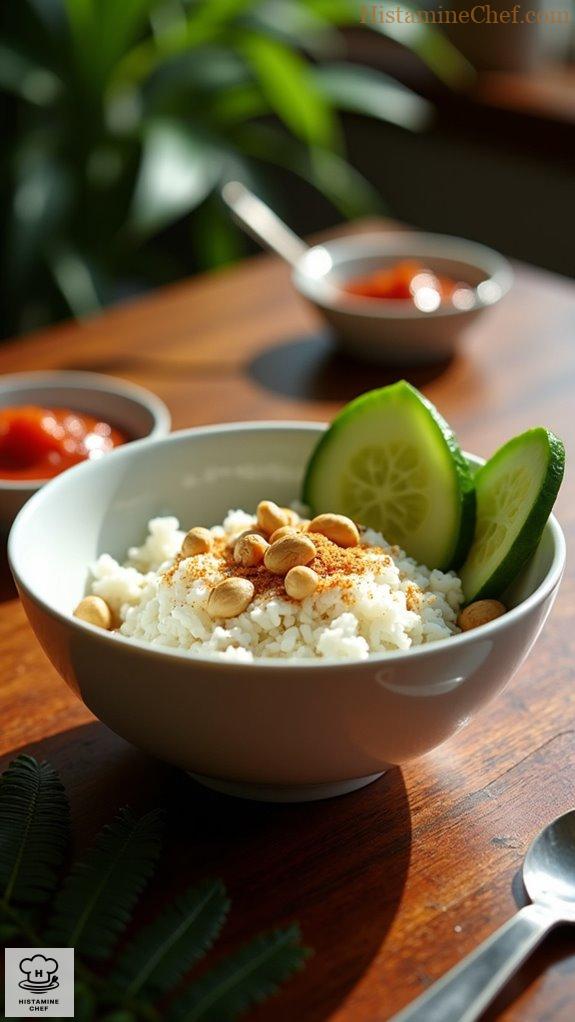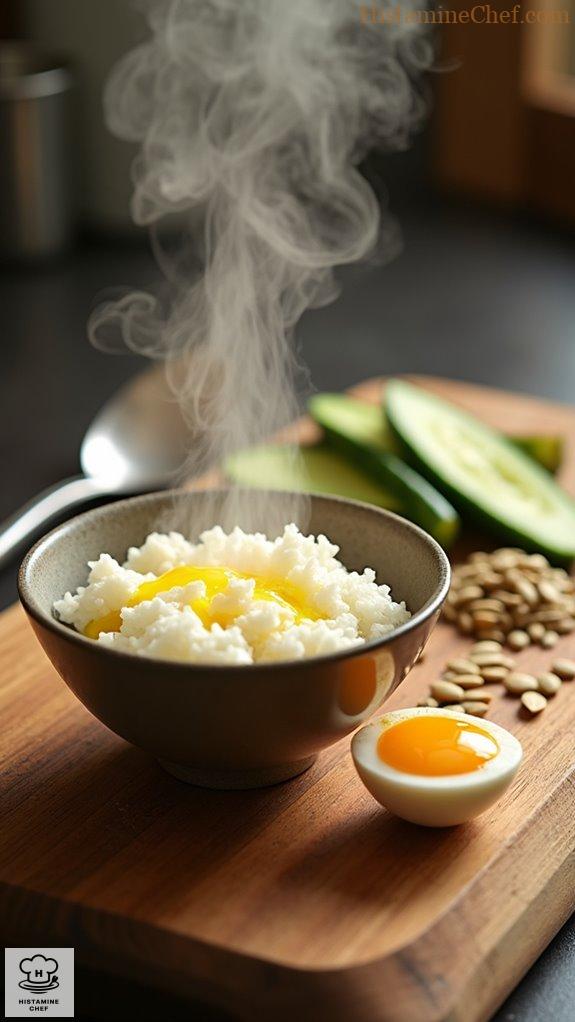Craving Nasi Lemak but worried about histamine? I’ve got you covered! Picture fragrant coconut rice, but instead of traditional sambal, let’s swap in a mild coconut chili sauce. Toss in fresh cucumber slices, roasted pumpkin seeds, and say goodbye to anchovies and peanuts; sunflower seeds are the nut-free twist we need! Who knew enjoying this Malaysian classic could be so safe and delicious? Stick around, and I’ll share more delightful variations and tips just for you!
Bustling Cityscape of Kuala Lumpur

Kuala Lumpur, the vibrant heart of Malaysia, is renowned for its rich street food culture, where culinary traditions meld with a tapestry of flavors reflecting the nation’s multicultural population. The streets are lined with hawker stalls and food carts, each offering an array of dishes that tantalize the senses, most significantly the iconic Nasi Lemak.
Historically, this beloved dish originated from Malay rice farmers, who’d prepare it as a hearty meal to sustain them during long hours in the fields. Over time, Nasi Lemak evolved, integrating diverse influences from Chinese, Indian, and indigenous cuisines, making it a symbol of Malaysia’s multicultural identity.
Food vendors have become an integral part of this urban environment, showcasing dishes prepared with fresh ingredients, often cooked in front of patrons, creating a lively atmosphere. The street food culture not only provides an accessible dining option for locals but also serves as a platform for communal interaction, celebrating the nation’s culinary legacy.
As Kuala Lumpur continues to grow, its street food scene remains an essential part of the city’s charm, inviting locals and tourists alike to savor the essence of Malaysia through each delicious bite.
Coconut Milk Simmering in Pots

Street vendors cook Nasi Lemak by first bringing coconut milk to a gentle simmer in large pots over an open flame.
This rich, aromatic milk is often enhanced with pandan leaves and a pinch of salt for flavor.
Once the coconut milk is simmering, they add rice, which is then cooked slowly to absorb the creamy liquid, resulting in fragrant, flavorful rice that serves as the base of the dish.
As the rice cooks, vendors prepare various side dishes, ensuring everything is ready to serve fresh and piping hot, making it a beloved street food item.
Ingredients:
- 2 cups jasmine rice
- 1 cup coconut milk
- 2 pandan leaves
- 1 teaspoon salt
- 1 cucumber (sliced)
- 4 hard-boiled eggs
- 1 cup fried anchovies (optional)
- Sambal (spicy chili sauce)
Cooking Steps:
- Rinse and soak jasmine rice.
- Combine coconut milk and pandan leaves.
- Bring the mixture to a simmer.
- Add soaked rice to the coconut milk.
- Season with salt and stir gently.
- Cook until rice absorbs liquid.
- Prepare hard-boiled eggs and sides.
- Serve rice with cucumber and sambal.
Prepare Coconut Rice”

To prepare Coconut Rice for your Homemade Malaysian Nasi Lemak, start by rinsing and soaking 2 cups of white rice in water for about 30 minutes.
In a pot, combine the soaked rice with 1 cup of coconut milk, 1 cup of water, and a pinch of salt. Add a few slices of fresh pandan leaves for authenticity.
Bring the mixture to a boil, then reduce the heat, cover, and simmer for 15-20 minutes until the rice is cooked and the liquid is absorbed.
Fluff the rice with a fork and let it sit covered for a few minutes before serving, allowing the flavors to meld.
Cooking Steps/Ingredients Changes:
- Use white rice instead of brown
- Rinse rice before cooking
- Add coconut milk for flavor
- Include pandan leaves for authenticity
- Adjust salt to taste
- Simmer until liquid is absorbed
- Fluff before serving
Low Histamine Variation of Nasi Lemak

Histamine intolerance can complicate the enjoyment of street food, as many popular dishes contain high-histamine ingredients or those that liberate histamine in the body. Moreover, the food handling and preparation methods of street vendors can exacerbate the histamine content of dishes, making them even less suitable for individuals with histamine issues. Preparing meals using low histamine techniques can significantly improve safety for those affected by this intolerance.
Eating street food such as Nasi Lemak can be problematic due to its typical ingredients like sambal, fried foods, and processed meats, which are often restricted for those with histamine intolerance. The SIGHI list highlights that many components, such as soy sauce and dried fish, fall under restricted categories, leading to elevated histamine levels and potential adverse reactions. In addition, street food often lacks precise ingredient labeling, complicating the selection for those needing to manage their histamine intake.
Low Histamine Variation Cooking Instructions for Nasi Lemak
- Use white rice instead of rice cooked with coconut milk.
- Omit sambal (chili paste) due to restricted ingredients.
- Replace any fried fish with freshly cooked or frozen fish.
- Substitute hard boiled egg whites with only the yolks or quail eggs.
- Use fresh cucumber slices instead of pickled or fermented vegetables.
- Skip peanuts; consider using sunflower or pumpkin seeds as an alternative.
- Cook with extra virgin olive oil instead of palm oil.
- Avoid any ready-made sauces or condiments to maintain low histamine.
- Serve with fresh herbs like cucumber instead of chili-based garnishes.
- Keep all prepared items in the refrigerator to reduce histamine build-up.
Additionally, fermented foods are known to commonly trigger histamine reactions, making it essential to choose alternatives that are low in histamine.
Video Summary
Nasi lemak is a beloved Malaysian dish with deep cultural roots. It’s often enjoyed as a hearty breakfast. Later, we’ll discuss a home-style, low histamine variation of this classic.
Street vendors typically prepare nasi lemak by cooking fragrant rice in coconut milk, pandan leaves, and a pinch of salt. This creates a rich, creamy texture that embodies the essence of the dish.
Once ready, the rice is served with a side of spicy sambal, made from chili peppers, garlic, and shrimp paste, sautéed to aromatic perfection. Fried crispy anchovies and roasted peanuts add texture and flavor. A hard-boiled egg sits on the plate, alongside fresh cucumber slices. This combination makes each mouthful a delightful explosion of flavors.
For our home low histamine version, start by replacing the traditional sambal with a milder coconut chili sauce. Use chili peppers sparingly and avoid shrimp paste. Cook the rice using 2 cups of jasmine rice and about 400 milliliters of coconut milk, with a pinch of salt.
A bamboo steamer or rice cooker can simplify this process. Prepare your protein by frying 2 egg yolks until firm, rather than using whole eggs. Instead of anchovies, coat 1/4 cup of pumpkin seeds in olive oil and roast them for a crunchy topping. Substitute the peanuts with sunflower seeds for a nut-free option.
Add fresh slices of cucumber and serve on a beautiful plate. The final meal is visually appealing and bursting with creamy coconut flavor, paired with fresh ingredients. Don’t forget to click the link in the description for the full recipe.


Leave a Reply